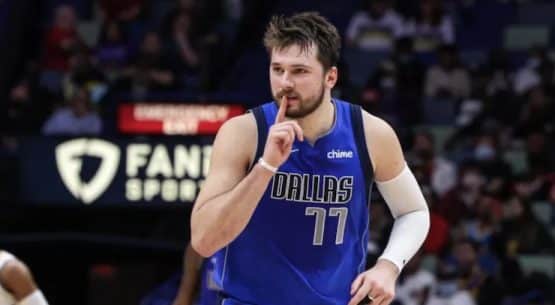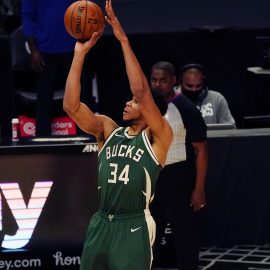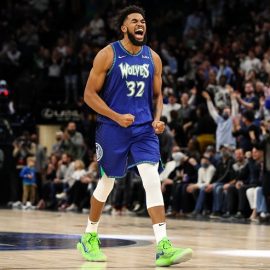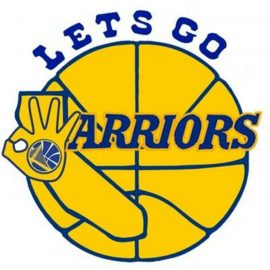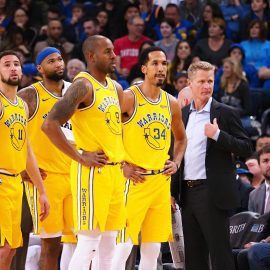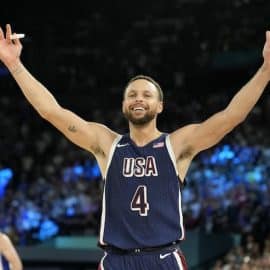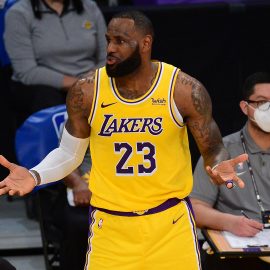The Nets are bound to be among the bottom handful of teams again in 2016-17, with only Boston’s first round pick at the end of the tunnel. However, Justin Hamilton has the goods to survive and thrive as a stretch-5.
Standing 6-11 with a near 7-2 wingspan, Hamilton has the height, speed, and stroke to succeed in today’s NBA. Draft Express lists Spencer Hawes as Hamilton’s best-case scenario and Uros Slokar as the worst. Nevertheless, Hamilton is much more mobile than Hawes and Slokar (though I’ve never seen or heard of him, I assume based on his name he’s not so swift-footed either). Of course, it’s understandable that Hamilton was projected as such given his build at a young age.
Hamilton is the definition of a basketball journeyman dating all the way back to his college days, but he may have finally found a home in Brooklyn. After two serviceable seasons as a role player at Iowa State, Hamilton transferred to LSU, where he redshirted before breaking out to the tune of 12.9 points, 7.2 rebounds, and 1.3 blocks in 30 minutes per game.
Hamilton was selected by the Philadelphia 76ers with the no. 45 overall and immediately dealt to the defending champion Miami Heat. Like most second round picks, Hamilton did not receive an NBA contract. Instead, it was off to Croatia and then Latvia, where he played well against grown men, albeit for under 20 minutes per game. It was fair to start asking whether Hamilton would have been better off staying in college rather than forgoing his senior year to enter the draft.
Then in 2013-14, Hamilton took his talents to the D-League and did not disappoint, tallying 19.5 points on 62.1 percent shooting, 9.3 rebounds, and two blocks. This was also the first time Hamilton flashed an ability to sink perimeter jumpers, making 0.8 per game at 39.7 percent during 38 contests. Hamilton’s D-League efforts earned him a shot with the team that traded for him on draft night.
Still, it was short-lived, as the Heat waived him after a brief seven-game stint. A year later, Miami brought Hamilton back for 24 more games, but again it wasn’t meant to last. After being acquired by the Pelicans at the trade deadline, he was waived before signing on with the Timberwolves to finish 2014-15. There he averaged 9.0 points (51.3 FG, 33.3 3Pt, 82.5 FT), 5.1 rebounds, 1.5 blocks, 1.4 assists, and 1.1 steals in 24.9 minutes per game. At that point, Hamilton appeared to be on the verge of receiving his first real NBA deal that summer.
To perform at that level and not get picked up by one of the 30 clubs shows how tough it is for players to stick in the NBA. Hamilton spent 2015-16 in Valencia posting his most efficient professional seasons while continuing to hone his outside game. For the first time at any level in his career, Hamilton drained one three per night, and he didn’t sacrifice efficiency, connecting on a career-high 43.3 percent across 41 games.
After Thaddeus Young was dealt to Indiana in exchange for a first round pick, it’s clear Brook Lopez could be the next piece to be moved as GM Sean Marks looks toward the future. Even if the Nets’ most established talent remains on the roster for the entire 2016-17 season, Hamilton’s opportunity to make a name for himself is rapidly approaching.
Lopez is a cheerful center with lots of skill on offense who conceivably still has a few pretty decent years left. The problem is the Nets are precisely that many seasons away from dreaming about sniffing a meaningful basketball game. If front offices are phoning in with first round picks for sale asking about Lopez, Brooklyn would be wise to accept. The price of picks is likely skyrocketing as the cap rises and more money starts flowing to veteran free agents receiving their second and third deals. This is another reason why Hamilton can be considered the X-Factor for Brooklyn: he’s an absolute bargain at only $3 million per year over the next two seasons even if he only proves himself to be a backup center.
Besides Bojan Bogdanovic and Sean Kilpatrick, the Nets were not exactly known for their outside shooting last year. Chris McCullough showed some promise in the final months by making 12 of his last 28 threes, but overall there was a lack of spacing that would make even those most comfortable in close proximities feel claustrophobic.
Among the Nets’ other new additions, Jeremy Lin’s three-point shooting has never been his strong suit, Anthony Bennett as a stretch-anything remains merely a theory at this point, and Trevor Booker’s campaign-high for made threes is 29—but Greivis Vasquez and Luis Scola were both useful as outside shooters in Toronto, Caris LeVert consistently improved as a shooter despite injuries during his four years at Michigan, and hometown hero Isaiah Whitehead can dial in as well .
This all points to Hamilton’s range off the bench being a huge key to how many wins the Nets can muster up in 2016-17. With Lopez on the floor, spot-up shooters like Bogdanovic and Kilpatrick will be afforded the space to fire away. Meanwhile with Hamilton on the court, guys like Rondae Hollis-Jefferson, Jeremy Lin, and Isaiah Whitehead will have more freedom to attack and drive the lane. The flexibility Hamilton offers to the second team should make for some fun reserve lineups that give the Nets a chance to play fast and carefree for the first time in forever, but most importantly gives the team a chance to find out what they’ve got in some of their young athletes.
Even if Hamilton peaks as a quality backup, his potential to help unlock the treasure chest of youth makes him the Nets’ X-Factor this season. It’s a common belief that big men take longer to develop and catch up to the speed of the NBA game than guards or wings. At 26 years old, Hamilton and Brooklyn remain hopeful that his best days are still ahead.
Add The Sports Daily to your Google News Feed!
